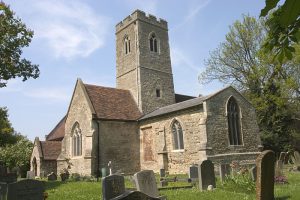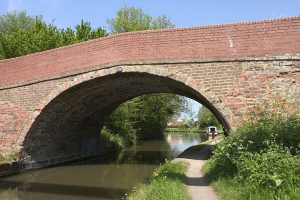There has been a community at Simpson since Saxon times when a man called Sigewine had a farm or tun here. Over the centuries Sigewine’s tun has gone through several transformations to become Simpson.
Over the centuries Sigewine’s tun has gone through several transformations to become Simpson.
The village and its one hundred or so inhabitants are recorded in the Domesday Book of 1086. It is possible that there was a church here before the Norman Conquest; no trace has been found of it, though the font in the nave may be Saxon. The present St Thomas’s church shows evidence of 13th and 14th century structures.
 A manor house was built in the 16th century, probably by Thomas Pigott. It was situated to the east of the church in what is now the Linear Park, near the River Ousel. The building was demolished in 1806 but the lines of the walls are still visible as are those of the fish ponds closer to the river.
A manor house was built in the 16th century, probably by Thomas Pigott. It was situated to the east of the church in what is now the Linear Park, near the River Ousel. The building was demolished in 1806 but the lines of the walls are still visible as are those of the fish ponds closer to the river.
In the 18th century the Hanmer family were the principal landowners in the Simpson area and it was Walden Hanmer who pursued the idea of enclosing the existing open field system. When this was finally agreed by Parliament in 1771 the appearance of the landscape changed dramatically, with newly drawn field boundaries. Some of the related hedgerows are still visible today. The Old Groveway road, running east-west to the A5 Watling Street also came into existence.
The early 19th century saw the arrival of the Grand Junction Canal which linked London and Birmingham. 
This important transport route though Simpson had major implications for local trade and the life of the population. The clay subsoil was idea for making bricks, which were fired in lime kilns alongside a wharf on the southern side of the village and transported by barge.
By the 20th century Simpson was still a small village – about sixty homes in the 1930s, together with a Post Office, a general store, a pub, a bakehouse and a forge. During World War 2 a number of workers from the Government Code and Cypher School at nearby Bletchley Park were billeted in the village. These included the novelist Angus Wilson and Harry Hinsley, who subsequently wrote the definitive history of intelligence in the war.
With the advent of the new town of Milton Keynes, Simpson was one of the first areas to experience development and growth. Hanmer Road, Lissel Road, Warren Bank and Chandler Court were all constructed in the early 1970s.
